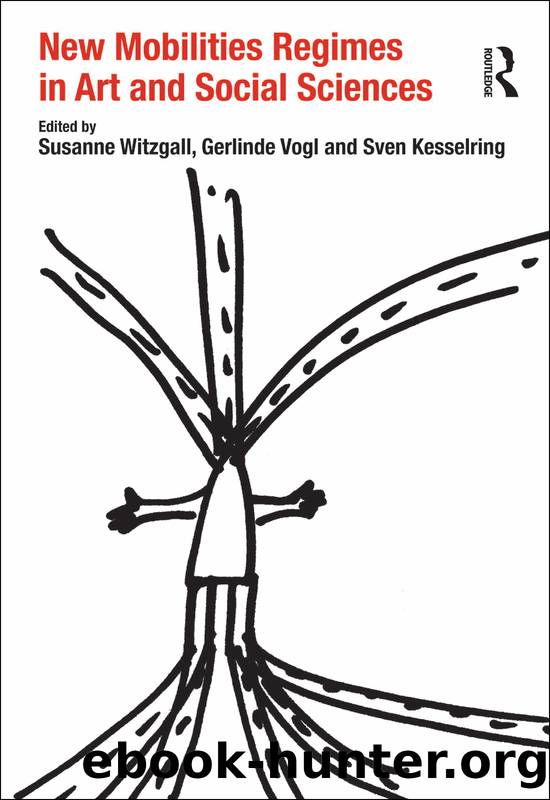New Mobilities Regimes in Art and Social Sciences by Witzgall Susanne;Vogl Gerlinde;Kesselring Dr Sven; & Gerlinde Vogl & Sven Kesselring

Author:Witzgall, Susanne;Vogl, Gerlinde;Kesselring, Dr Sven; & Gerlinde Vogl & Sven Kesselring
Language: eng
Format: epub
Publisher: Taylor & Francis Group
Published: 2013-08-15T00:00:00+00:00
TRANSGRESSION
As the transgression of the inside-outside divide, terror signifies an exception to order. The horizon of terror is the absolute fear of catastrophe, an enigmatic fear, a radical uncertainty which ruptures and disturbs the usual flow of time, setting it out of joint: terror as exception, coming from nowhere, with no reason and no warning. As an exceptional event, it has no origin in the frame of everyday life or governance, yet precisely for this reason it shatters the frame â a traumatic event that cannot be symbolized.
Let us at this point return to the concept of exception, which is essential to the camp. While for Schmitt the ânomos of the earthâ is geographical ordering, that is, the linking together of localization and order, there is a significant ambiguity in this: in the âstate of exception,â the inside-outside divide is transgressed, and the link between localization and order breaks down. The spatial structures from the concentration camp to Camp X-Ray on Guantanamo Bay emerge when the unlocalizable (the state of exception) is granted a permanent and visible localization. This coincidence of order without territory (the state of exception) and territory without order (the camp as a permanent space of exception) signals, in turn, the advent of âthe political space of modernity itselfâ (Agamben 1998, 20, 174â5). In other words, the location of unlaw within the law, the transgression of the law by the law itself, its self-suspension, is not merely an historical anomaly but is characteristic of modernity.
The concept of sovereignty grounds the inscription of transgression within the state. Sovereignty is, Schmitt argues, a âborderline conceptâ through which the essence of the political can be uncovered. Thus, it must not be identified with the presence of a monopoly of violence, the existence of a people etc., that is, as internal sovereignty. But neither is it to be identified with other statesâ recognition of a state as âexternalâ sovereignty. The ârootâ of sovereignty is to be found elsewhere and is only to be unmasked in those situations characterized by extreme, mobile danger. In these situations, sovereignty establishes and manifests itself as an abyssal decision. And so does the camp. The camp is the exception incarnated and, as such, it reveals the essence of âthe politicalâ and âthe social.â
In the state of exception, the distinction between a transgression of the law and its execution is blurred (Agamben 1998, 57). The violence exercised âneither preserves nor simply posits law, but rather conserves it in suspending it and posits it in excepting itself from itâ (ibid., 64). Consequently, a zone of indistinction emerges between law and nature, outside and inside, violence and law. Following this, the distinction between friends and enemies is blurred: the state starts treating its own citizens as potential enemies, as mobile outsiders. As oneâs status as a citizen ceases to remain taken for granted, it becomes something to be decided upon. In this, what is outside is included not simply by means of an interdiction or an internment, but rather by means of the suspension of the juridical orderâs validity.
Download
This site does not store any files on its server. We only index and link to content provided by other sites. Please contact the content providers to delete copyright contents if any and email us, we'll remove relevant links or contents immediately.
Chaco's Northern Prodigies : Salmon, Aztec, and the Ascendancy of the Middle San Juan Region after AD 1100 by Paul F. Reed(335)
Law Enforcement Interpersonal Communication and Conflict Management by Brian Douglas Fitch(330)
Digital International Relations by Unknown(324)
Critical Perspectives on Human Security : Rethinking Emancipation and Power in International Relations by David Chandler; Nik Hynek(312)
Skilled interpersonal communication: Research, theory and practice, Fifth edition by Owen Hargie(307)
The Enduring Color Line in U.S. Athletics by Krystal Beamon Chris M. Messer(305)
Evidence-Based Policy Making in Labor Economics by Hamermesh Daniel S.;Nottmeyer Olga K.;Nottmeyer Olga;King Sarah;King Sarah;King Sarah;(272)
EPSO CAST Political affairs EU policies: How to succeed in the selection procedure by Franco Reverte José María(269)
Writing Public Policy - A Practical Guide to Communicating in the Policy Making Process by Catherine F. Smith(252)
Threshold Concepts in Women's and Gender Studies by Christie Launius Holly Hassel(247)
Criminological Theory in Context by John Martyn Chamberlain(246)
Tibeton Yoga Its Secret Doc by Evans-Wentz(244)
Social Problems, Social Issues, Social Science by James Wright(243)
Positive Psychology and Spirituality in Counselling and Psychotherapy (Conflict, Ethics, and Spirituality, 12) by unknow(241)
Rothschild and Early Jewish Colonization in Palestine (Geographical Perspectives on the Human Past) by Ran Aaronsohn(240)
Cognitive Development in Infancy and Childhood (Elements in Child Development) by Mary Gauvain(234)
Play in child development and psychotherapy: toward empirically supported practice by Sandra W. Russ(232)
Latin American Politics and Society by Gerardo L. Munck & Juan Pablo Luna(206)
What Makes a Social Crisis?: The Societalization of Social Problems by Jeffrey C. Alexander(206)
